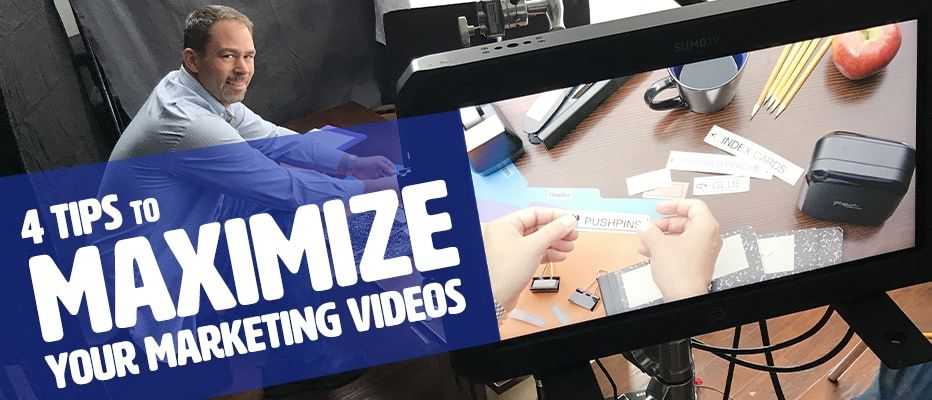I’ve always said that a 60-second marketing video engages hearts and minds far more effectively than 60 paragraphs of copy. Industry publication Marketing Land reported that LinkedIn users are over 20x more likely to share video content within the platform than an article. And Hubspot tells us that 54% of consumers want to see more video content from the brands they support.
It’s clear that video should be part of your organization’s marketing efforts. And whether you have a well-established process or are new to the video production process, these four tips will help you to get the most out of your marketing videos…
#1 Start with a Plan

From writers and designers to film crews and editors, it takes a village to create a compelling video and production costs add up quickly. That’s why it’s crucial for all involved (client, agency, talent, etc.) to begin with a well-documented vision of the end goal.
We begin all video projects with research and interviews to gain a clear understanding of customer pain points, aspirations and how our clients’ products or services make their lives better. This helps us write a compelling story that will resonate with the target audience.
Then, we produce detailed storyboards that depict exactly how we plan to execute every scene and graphic within the video. Though the original vision may evolve during the production process, taking this step allows everyone to see a visual representation of the end result before any filming, animating or editing begins, offer their input and ultimately buy in to the vision. The storyboards then serve as a guide for all stakeholders in the production — from set designers and film crews to actors and editors.
Storyboards from a recent Brother commercial helped a complex video turn out just right… View the Case Study
#2 Make it Resonate

When it comes to marketing videos, people respond to simple stories that they can relate to and that tug at their heartstrings in some way. Whether it’s hearing the testimonial of a family that survived a hardship, seeing how apparel keeps hardworking heroes safe and comfortable or experiencing how a piece of software creates a more productive work environment, the viewer needs to be able to connect to the characters and content and imagine themselves as the protagonist in the story. In other words, simply listing off a series of features and benefits won’t be enough to engage most viewers.
See how we brought out Ansell’s passion for protecting heroes in an emotional way… View the Project
#3 Use Supporting Text Graphics

According to Instagram Business, 85% of all Facebook videos and 40% of Instagram videos are watched with no sound. Thus, in addition to grabbing audiences with beautiful visuals and audio, it’s equally important to reinforce key messages with text graphics that can be read and understood with no sound required. We try to feature a well-designed text “super” every few seconds in all marketing videos that we produce.
The Americans with Disabilities Act (ADA) recommends in article 1.2.2 that “all video with sound contains accurate closed captioning” as an alternative for the hearing impaired. While U.S. courts are still unclear about how this affects video content on the web (rather than on TV), there are firms in the U.S. scouring the internet right now and firing lawsuits at non-ADA-compliant companies. These suits often target smaller companies and non-profits that lack the resources to put up a fight and are more likely to pay a settlement. Perhaps because of this, or maybe out of altruistic intentions, some online retailers will no longer post product videos that don’t include closed captioning.
As a precaution and to help ensure maximum reach, we recommend including closed captioning with all marketing videos. Luckily, online tools like YouTube’s Video Manager or third-party software like CC Creator make adding captions simple.
#4 Keep It Concise

There’s an abundance of video content out there trying to capture and sustain our short attention spans. So, it’s extremely important to keep your videos as short as possible. HubSpot recently reported that videos that were 26 seconds long received the most comments on Instagram, and Facebook audiences engaged most with 60-second videos.
To be fair, it’s not always realistic to tell your story that quickly. (We’ve found 90 seconds to be the sweet spot for many of our clients.) A good workaround is to slice up your 90-second longform video that’s featured on your homepage or product page into several 10- to 30-second snippets for use on social media. Not only does this cater to shorter attention spans, it allows you to stretch your video investment into multiple social posts and marketing campaigns.
Check out these snippets we use in our social media campaigns… View the Projects
If you and your video partner start with a plan, make it resonate, use supporting text graphics and keep it concise, you’ll find that videos are not only powerful marketing tools, they’re also a lot of fun to make. Feel free to drop us a line if you have questions about the process or would like to explore a video project for your business.

